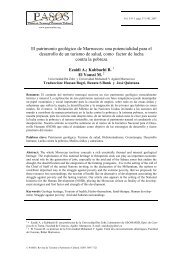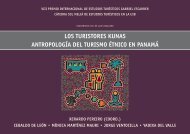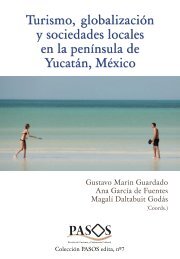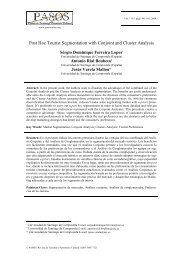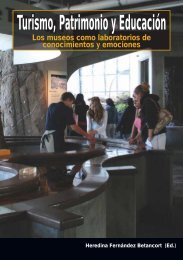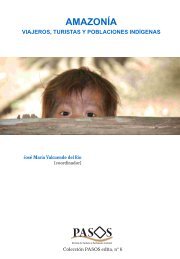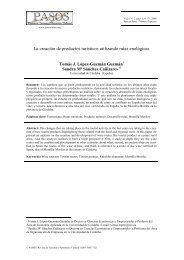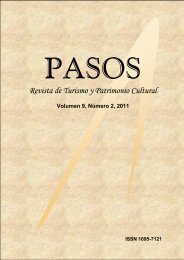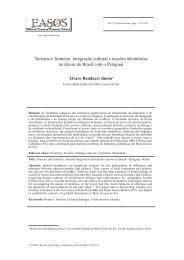Full Journal - Pasos
Full Journal - Pasos
Full Journal - Pasos
You also want an ePaper? Increase the reach of your titles
YUMPU automatically turns print PDFs into web optimized ePapers that Google loves.
92 Repositioning of Barcelona’s Image in the Light of a Redefinition of the Urban Tourism Planning Model<br />
––<br />
Incorporation of new technology in managing<br />
city tourism<br />
––<br />
Introducing new business concepts<br />
––<br />
Organisational integration and flexibility<br />
2.1.1. City sustainability<br />
Regarding city sustainability, the development<br />
of sustainable tourism in an integrated<br />
process in which social, economic and environmental<br />
factors are interrelated by the agents<br />
who manage them (Sancho, 2007). Each city<br />
must therefore choose its own path to sustainability<br />
(Bariol, 2010), depending on the needs in<br />
each urban development life cycle. Sustainability<br />
is based on:<br />
––<br />
Economic viability. Using population wealth<br />
indicators ensures the city economy is most<br />
profitable at any given moment and, in the<br />
case of tourist cities, that tourism development<br />
fosters economic development for society<br />
as a whole.<br />
––<br />
Socio-cultural viability. Citizens get visible<br />
quality of life in terms of training, quality<br />
jobs, health, housing, green spaces, culture,<br />
infrastructure, facilities and conservation of<br />
their cultural identity.<br />
––<br />
Environmental viability. Tourism development<br />
must be based on exploitation of an area<br />
in which regeneration outstrips use. In other<br />
words, tourism must put right any environmental<br />
damage caused by tourists’ land use.<br />
Three key issues need solving in connection<br />
with this triple sustainability. The first concerns<br />
the model’s long-term economic viability.<br />
The viability of tourism projects and rehabilitation<br />
work has been effectively tackled in those<br />
French cities (some 2,500 municipalities) and<br />
world ones (among them, Amsterdam, Brussels,<br />
New York, and Tokyo) that have levied a tourism<br />
tax on overnight hotel stays. The approach has<br />
created standing funds earmarked for ongoing<br />
development of local tourism. It is true that<br />
such taxes are solely borne by hotels (hoteliers<br />
complain it makes their accommodation more<br />
expensive while leaving other tourism products<br />
unscathed). On the other hand, public spending<br />
on tourism will not rise over the medium term<br />
given the economic crisis. More advanced tourist<br />
cities will have to balance contributions in this<br />
area. Cities that do not levy a tax on tourist<br />
hotel stays are forced to fund tourism from citizens’<br />
taxes, who end up paying for the dubious<br />
privilege of sharing city facilities with tourists.<br />
Whichever way one looks at it, a direct tax on<br />
tourists yields a balanced solution over the short<br />
term for most cities.<br />
A second key issue linked to sustainability<br />
is the link between ‘carrying capacity’ and ‘ecological<br />
footprint’. An area’s carrying capacity is<br />
the extent to which peak demands can be met<br />
without these seriously affecting the area’s<br />
functioning (Ingurumena, 2003). The ecological<br />
footprint is the amount of resources an area<br />
requires to meet the demands made upon it by<br />
lifestyle and consumption habits (Rees, 1992;<br />
Wackernagel, 1994; 1996).<br />
Some pioneering cities, of which Venice is<br />
a shining example, have established automatic<br />
measures to stop tourism crossing certain<br />
thresholds. However, as with the previous issue,<br />
knowledge of the carrying capacity of main streets,<br />
the most visited sights and neighbourhoods<br />
is key to achieving city sustainability, which is<br />
the main aim of local Agenda 21 plans.<br />
The third issue regarding the planning of<br />
competitive, sustainable tourist cities concerns<br />
‘resilience’, which means a city’s ability to reinvent<br />
itself and strike a new balance after<br />
alteration by external agents (Alberti et al,<br />
2003). The UN’s World Tourism Organization,<br />
UNWTO, set up a Tourism Resilience Committee<br />
in 2009 specifically to help tourist economies<br />
face the crisis and to create and pool knowledge<br />
regarding ways of adapting and changing the<br />
tourism model.<br />
2.1.2. Integrated Management and Governance<br />
Apropos management and governance, it<br />
should be borne in mind that city tourism planning<br />
is a system of interconnected functions and<br />
processes to yield quality products and services<br />
for and sustainable management of the urban<br />
community” (Paskaleva-Shapira, 2007). In this<br />
connection, most large European cities have set<br />
up tourism boards (most of which are publiclyrun<br />
but there are some public-private partnerships)<br />
for promoting their respective brand images.<br />
As cities have focused more on this task,<br />
they have largely ignored others such as: creating<br />
tourist products; actively developing human<br />
capital and tourism logistics throughout the city;<br />
exploiting technology; co-ordinating tourism.<br />
Planning economic and financial resources for<br />
long-term city development has been overlooked<br />
completely (Valls, 2004). The way powers are<br />
split between various municipal bodies has led<br />
to poor co-ordination of city tourism planning<br />
and implementation of its strategies and poli-<br />
PASOS. Revista de Turismo y Patrimonio Cultural, 11(1). 2013 ISSN 1695-7121



